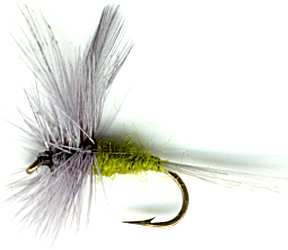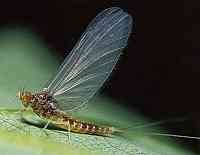The Blue Winged Olive Dry Fly BWO
The Blue Winged Olive (BWO) is just one common name used to describe some, but not all, members of the insect family groups called Baetis (pronounced beet-us) Ephemerella, Baetidae, Drunella and Diphetor.

DRY FLY PATTERNS. Hook size 12 14 16 18 20 24 - $US each
Other names for the Blue Winged Olive Mayfly include Bluewing, Tiny Olives, Iron Blue Dun, Iron Blue Quill, Little Slate Winged Olive, Little Slate Winged brown quill, Tiny Western Olive and Little Western Iron Blue Quill. There are many species of Blue Winged Olive mayflies. There are 153 species currently listed for North America. There is often confusion among fly fishermen because the species are difficult to distinguish. One fisherman will report success fishing a great hatch of Blue Winged Olives another on the same river will be discussing the pattern he used to imitate a Little Slate Winged Olive hatch. Quite often they are discussing the same insect.
It is very difficult to distinguish one species from another. Part of the reason for identification confusion is that the scientific names for major hatches of Baetis have changed recently. But who cares what the scientific name of a sub species of mayfly is. The trout do not care. To them food is food what ever it is called. When the trout are taking these early season mayfly, getting the size right matters more than an exact imitation. Hatches begin as early as February and continue until November. Those fly fishermen that only pick up their rod in the late spring and summer months really miss some fine fishing. Hatches normally start just after lunch. Search out back-eddies on the river. This is where I normally find blue-winged olive circle endlessly around and around. I think they like the air currents and this is where you will find the trout ready to suck them down. This fly also works well in slow run stretches of water. Use your eyes and hunt the swarms. Look out for airborne insect eating birds like swallows feasting on or near the water surface.
Blue Winged Olive mayflies imitations can catch trout throughout the flyfishing season. The disadvantage is that you have to carry a variety of hook sizes as one Blue Winged Olive will emerge in the morning and needs a hook size 12 BWO fly whilst another emerges at dusk and requires a hook size 20 fly. The presence of rising trout gently sipping something from the water's surface with no duns visible on the water generally means that the trout are taking the suspended nymphs and emerging duns. The Pheasant Tail Nymph and Gold Ribbed Hare's Ear nymphs are ideal imitations for the blue-winged olive's early stages. Drift them near the bottom any day between September to April that is if your part of the world is not covered in ice. When it is hatching time the emerging duns have to wait in the water surface for about a minute for their wings to dry. Trout love this time of the year as it is easy pickings. Try a Shipman’s Buzzer, Suspender buzzer, Klinkhammer or Parachute fly to mimic these emerging duns.

Do not worry if your casting fails to produce a fly that is standing up on its hackles. Trout are used to feeding on emerged Olive Duns that are waiting for their wings to dry but then get blown onto their side. Many right themselves up and eventually fly away but a fair number get caught in the water surface film. They eventually drown. these are easy pickings for the hungry trout.
My top flies for fishing the famous chalk stream river Itchen in southern England are as follows, Blue Winged Olives, Humpy, Black Gnat, Red Wulff, Grey Wulff, Elk Hair Caddis, Tricolore, Hawthorn, Adams, Daddy Longlegs, Sherry Spinner and Beacon Beige. Mid April and for the following six weeks are the best. Too many people who fish chalk streams are in a hurry. My advice to many anglers is to slow down, if you want catch fish. When observing the river, the faster you walk the less you will see. If you walk slower you will see more. And if you stay in one spot for a long period, the chances of seeing everything you are likely to see increase. Standing still automatically improves your vision of what is happening under the water surface and on top of it. Don't spook the fish. Approach the riverbank stealthily and stay low. Look in spiders webs and turn the leaves of large leafed plants upside down to see what hatched last evening. You were given eyes so use them to help you plan your tactics for fishing that stretch of the river.

You will catch more trout by sweeping the water with your eyes, looking for opportunities to cast to. This is more productive than continuously casting to cover the water in an effort to scout around looking for likely fish that may just take your fly. It is very rare to see the classic rise forms growing bigger out across the river in ever increasing circles on the chalk stream or river. To spot fish look for changes light on the surface. An insignificant flicker just under the surface becomes your opportunity.
Unlike a Stillwater Trout that has to go out hunting for food, trout in the chalk stream like to position themselves somewhere along the river where they can pounce on whatever the current floats in front of them. Most clear water chalk stream trout do not move location very often during the day. But they do move to feed and that is what you must watch for. A big trout lurking under a weed bed slowly move, inch by inch, slowly putting to one side, or drifting back to intercept a dislodged invertebrate or passing shrimp. There are certain times when it is easier to notice that trout's position, for example, if it sees the shadow of a bird flying overhead or it is disturbed by the arrival of another trout.
You have to be ready spot these giveaway, fraction of a second, you tell-tale signs. Always have a big breakfast will bring some sandwiches with you because you your busiest time on the chalk stream should be during and just after lunch. You should spend this pre-hatch time working out where the fish are lying, so you are ready to spring into action when the hatch arrives. I prefer flies hook size 14 to 16. If you see trout taking flies by lifting out of the water, rather than sipping at floating spinners, this is normally a big clue that blue winged olives are the right fly to use.
Fly fishing a small river
A few olives trickled off the water, but nothing moved to them as I made my way along the tortuous course of the little Welsh river. The footpath that used to be used by the silver miners 200 years ago was now overgrown in parts.
Then, there in the main current, a fish moved but to what I could not see. It did not break the water surface. The fish rose again and I cast, or rather flicked in hope, a short length of line in the knowledge that this fellow was a ‘one-shot only fish’. If he got spooked he would be gone. I had tied on a size 16 Blue Winged Olive Dry fly. Being a complete gentleman, he took the first cast and was secure.
Then I realised that I had not taken into account of how the devil I was to net the thing. I was at least 4 feet above the water surface with an angry small trout trying to enmesh me in debris and other aquatic obstacles that he had known about all winter. But after a quick exercise in mountaineering, I had him in the net.
Slightly upstream I saw another fish. This one was grubbing around on the river bottom. This location again was not an easy place to land a fish, but being wise after the event, I planned a course of action and left my net at the point I predicted I would land the fish if I caught it.
I tied on a beaded hackled Pheasant tail nymph on a size 16 hook. At my first cast, my nymph hung up in a willow branch. The next cast was better insomuch as I hit the water but nowhere near the fish. I recast again and this time I had him with a slight lift then pause of my tiny pheasant tail nymph. This caused the hackles around the bead head to move up and down so the fly looked alive and good to eat. He came to my strategically placed net, all 14 inches of him.
The lesson I took from this fishing trip was not to be so impatient to get a cast onto the water. Think ahead. If I catch the fish I am casting too how and where am I going to land him? What is the best place and should I leave the net at this location. I could have so easily lost both of these fish. Luck was with me for the first one and planning helped with the second.
Customer's Comment
Blue Winged Olive Dry flies in hook size 16, 14 and 12 are in my top ten list of flies. Most of my fishing is on rivers and streams in Maine, USA. Occasionally I'll canoe a few ponds. Most noted are the rivers of Kennebec, Penobscot, Moose, Crooked, Rapid, Messalonskee, Kenebago, Grand Lake Stream, Magaloway, Dead River, Kenduskeag and Sebasticook. As always tight lines, Jeff Haresear
Customer's Comment
I fish the rivers of the Welsh Boarders. In Autumn the large Dark olives put in a second appearance, but in smaller quantities from those that hatched in May. Blue Winged Olives provide good dry fly fishing opportunities for surface feeding grayling and trout during mild spells in the weather even into November and December - John Langdon


Fly Fishing books

